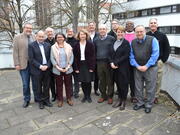-
Speaker’s bureau
Invite the global church into your congregation! MWC member congregations are welcome to invite one MWC speaker per year to bring a message from the global Anabaptist-Mennonite family. This may be for Anabaptist World Fellowship Sunday, Peace Sunday or any day you wish to give special attention to the global family. Please consider giving an
-
Ressources sur l’histoire et la théologie anabaptistes
Il existe de nombreuses ressources en langue française sur l’histoire et la théologie anabaptistes. Cliquez ici pour une bibliographie mise à jour par Claude Baecher Cliquez ici pour la Bibliothèque numérique anabaptiste
-
Restoring Our Family to Wholeness: Seeking a Common Witness
A Common Statement of Confession, Gratitude and Commitment Mennonite World Conference appointed several people to participate in an ongoing ecumenical dialogue with the World Communion of Reformed Churches (WCRC). This is one of the state churches who in the 1500s persecuted the early Anabaptists in Europe. Together, this group of theologians from WRCR and MWC
-
Resources regarding the baptism report
Study guide Growing in Faithfulness: Living out our baptism Guide for study and reflection on Baptism and Incorporation into the Body of Christ, the Church: The Report of the Trilateral Conversations between Lutherans, Mennonites and Catholics (2012-2017) Report Baptism and Incorporation into the Body of Christ, the Church It was with the twin goals of
-
MWC Worship postcard 2022
We worship together while apart In Christ, and by the power of the Holy Spirit, the cultural adn national boundaries that separate us have been overcome by the cross. We celebrate Each year, MWC publishes worship resources with Scripture focus, sermon notes, testimonies, prayers and liturgies and activities that can be used in your congregation.
-
MWC Logo Kit
Your national church and local congregation can use the logo to show that you belong. MWC has created a downloadable images to post a badge on your website. Read more For national church For local congregation
